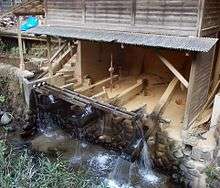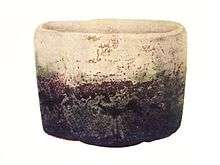Onta ware
_LACMA_M.2008.264.24.jpg)

Onta ware (小鹿田焼 Onta-yaki), also spelled Onda, refers to a type of Japanese pottery produced in and around the village of Onta in Ōita Prefecture, Japan.
History
The production dates back to the early 18th century CE. Onta ware is closely associated with Mingei folk art.[1]
Production
The earth for the pottery is found in Onta in the mountains. It normally comes in the form of rocks and needs to be ground to a pulver. This is done by the usage of traditional water scoops or mills called kara-usu, which rely purely on the flow of the river. The wooden mills grind the earth into a powder, which is then washed and filtered multiple times to purify the material. It is then dried, sometimes over a large oven.
The village is a tightly-knit community, with families of potters going back generations. The work such as the purification of the earth is done by women, while men are responsible for actually creating the wares. Pieces are never signed by an individual but only with the sign of the Onta village. This is to signify that the production of a single vessel was the combined work of the community, not just one person.
Onta ware traditionally consists of utility vessels such as bowls, plates, and tea cups. The style is most often slipware.
Heritage
Onta ware was inscribed by the national government in 1995 as an Intangible Cultural Property.[2][3] The area has also been inscribed as one of the protected 100 Soundscapes of Japan.
References
- ↑ http://gallery.arts.psu.edu/items/show/147
- ↑ "Database of Registered National Cultural Properties". Agency for Cultural Affairs. Retrieved 15 March 2011.
- ↑ "Ceramic Art and Crafts - 20.Onta-yaki" (PDF). Japan National Tourism Organization. Retrieved 2 May 2011.
Further reading
- Wilson, Richard L. (1995). Inside Japanese Ceramics: A Primer of Materials, Techniques, and Traditions. Weatherhill. p. 108. ISBN 978-0-8348-0442-5.
External links
![]() Media related to Onta ware at Wikimedia Commons
Media related to Onta ware at Wikimedia Commons
- http://ontaya.com
- http://www.japanvisitor.com/japan-city-guides/onta
- http://www.studiokotokoto.com/2013/05/07/a-tour-of-the-pottery-towns-of-southern-japan-part-ii-onta/
